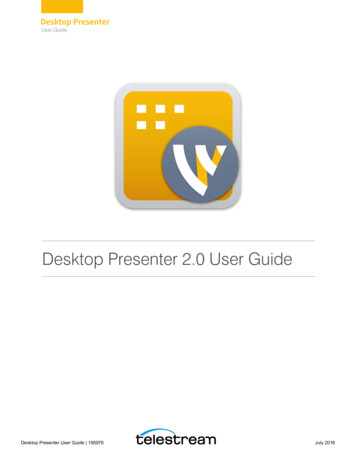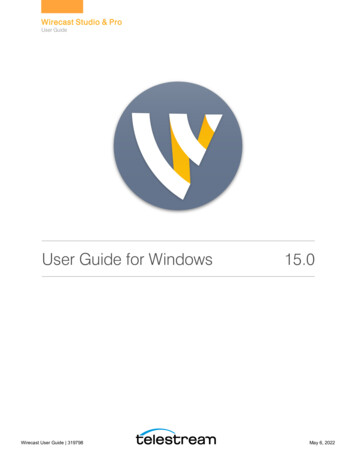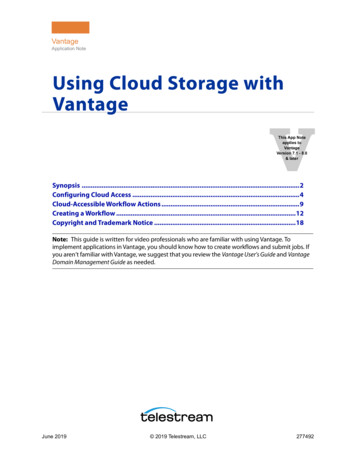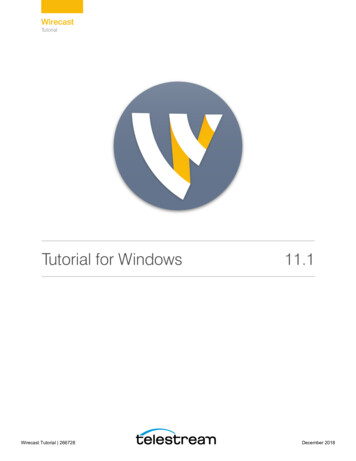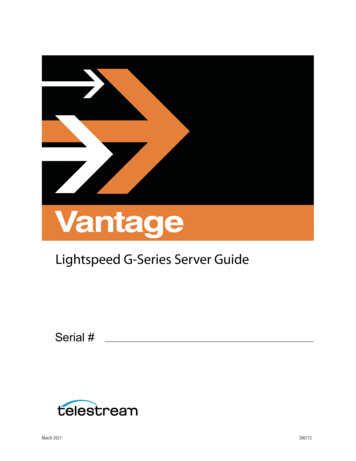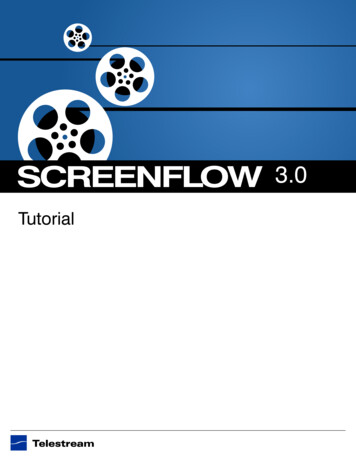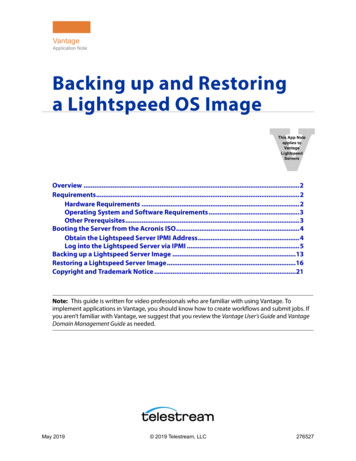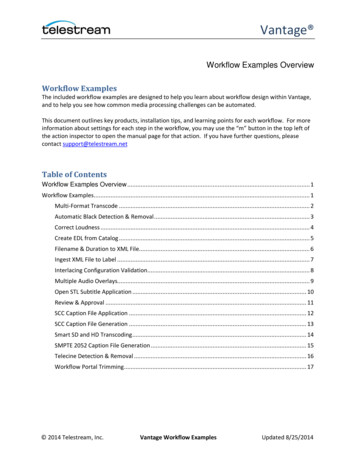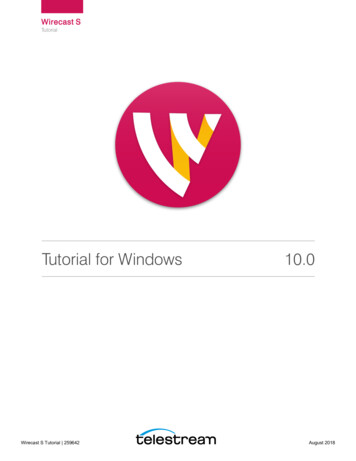
Transcription
Wirecast STutorialTutorial for WindowsWirecast S Tutorial 25964210.0August 2018
3InstallationIntroductionThis topic guides you through installing (or upgrading) and activating Wirecast S.Topics Installing Activating Uninstalling System RequirementsInstallingTo install Wirecast S, follow these steps:1. Download the installer from the Website at: http://www.telestream.net/wirecast/overview.htm2. Run the installer (.exe) program and follow the instructions provided3. If you have an older version of Wirecast S already installed on your computer, theinstaller upgrades to the newer version. Agree to the license terms and follow theinstructions displayed by the installer program.ActivatingWhen you purchased Wirecast S a serial number was provided. This serial number mustbe registered in the Wirecast S program to unlock the features of Wirecast S. To registerWirecast S follow these steps:1. Run the Wirecast S program.
4InstallationUninstalling2. Select Preferences from the File menu, select Licenses, then click Purchase. Once youpurchase and obtain your license number, enter it into the Serial Number field andclick Activate.Select LicensesClick PurchaseEnter serialnumberClick Activate3. Close the Preferences window.Your Wirecast S program should now be fully activated.UninstallingTo uninstall Wirecast S, follow these steps:1. Run the Wirecast S installer (.exe) program.2. The installer asks if you want to repair or remove the existing version. SelectRemove to uninstall the existing version of Wirecast S.System RequirementsOperating System Minimum: Windows 7, 8, 10 Recommended: Windows 10Processor Minimum: i5 dual-core @ 2.3GHzNOTE: May be insufficient for 1080p or 60 fps workflows Recommended: i7 quad-core @ 2.8GHz Memory Minimum: 4GB RAM Recommended: 16GB RAM
InstallationSystem RequirementsHard Drive Minimum: 2GB, 7200 RPM for record to diskNOTE: Additional hard disk space required for record to disk Recommended: 500GB , Solid State OS DriveGraphics Card Minimum: Intel HD, DirectX 11 capableNOTE: Insufficient for advanced Multi-Viewer workflows Recommended: Nvidia GeForce or AMD Radeon, 1GB video memoryInternet Connectivity Minimum: Open HTTP/HTTPS port 80, RTMP port 1935,port 7272 for Remote Desktop Presenter Recommended: If behind a firewall, check with your CDN for any sites to whitelistNote: You are strongly advised to run Wirecast S using the Windows Aero Theme,which includes a hardware accelerated window manager. Problems may result if youuse the Windows Classic Theme.Desktop PresenterUse the remote version of Desktop Presenter 2.0.8 with Wirecast S. It is available as aseparate download at: esktoppresenter.asp?prodid desktoppresenter.RendezvousWirecast Rendezvous uses WebRTC technology that can be very resource intensive. Forthe best experience, we suggest considering the following when choosing hardware.Note: The following recommendations are based on a single simultaneous stream of720p30 x264 @ 4.0Mbps.Bandwidth Add 4 Mbps Add 5 MbpsNOTE: To maintain reliability, bandwidth per guest decreases as more are addedProcessor i5 quad-core i7 quad-coreNote: These are minimum recommended processors. More demanding workflowsmay require a more capable CPU.5
6InstallationSystem RequirementsInternet Connectivity Requires internet connectivity with HTTP/HTTPS port 80, and RTMP port 1935 openfor streaming, Remote Desktop Presenter requires opening port 7272. An internet connection is recommended for Wirecast license activation.For lowest quality (240p) streaming an upload rate of at least 650Kbps is required.720p streaming requires an upload rate of at least 2500 Kbps.1080p streaming requires an upload rate of at least 4500 Kbps.Consider lowering your canvas frame rate and/or streaming resolution to lowerCPU usage. It is recommended that an upload rate of at least double the desired rate be available. Solid State Drive or fast RAID array recommended for ISO Recording and Replayfunctionality. Actual data rates will vary depending on quality level selected forMJPEG recording, as well as the resolution and frame rate selected. Windows MJPEG Best Quality Guidelines (Megabytes per second):– 1080i and 1080p 29.97 and 30 FPS, MJPEG Best Quality – 25MB/sec– 1080p 60 FPS, MJPEG Best Quality – 50 MB/sec– 720p 59.94 and 60 FPS, MJPEG Best Quality – 20 MB/secRecommended Hardware Specifications Intel Core i3 CPU @ 1.7 Ghz or higher recommended for 540p streaming with x264@ 30 fps. Intel Core i5 CPU @ 2.5 Ghz or higher recommended for 720p streaming with x264@ 30 fps. Intel Core i7 CPU @ 3.0Ghz or higher recommended for 1080p streaming with x264@ 30fps.Note: 60 FPS streaming will result in increased CPU usage and a high bit rate (4Mbpsor higher) for good quality. Intel HD, NVIDIA GeForce, or AMD Radeon class graphics adapter that is DirectX 11capable. Minimum 4GB RAM, 2GB free hard disk space. Additional hard disk space requiredfor recording to disk.Hardware Accelerated Encoding Requirements Intel Quick Sync Video encoding requires an Intel CPU with an Intel QuickSyncVideo core. List of Intel CPUs supporting QuickSync.NVIDIA NVENC encoding requires an nvidia GPU with Kepler architecture or newer.NVIDIA only maintains a general list of supported GPUs.
7TutorialsIntroductionThe best way to get started using Wirecast S is to quickly work through all its mainfeatures. This tour presents a series of three tutorials, each designed to help youunderstand how to create and stream presentations using Wirecast S.As you work through these tutorials, you will also become familiar with importantWirecast S concepts and how you can use them to deliver high quality broadcasts. Themore you know about Wirecast S, the better it will serve your streaming objectives.Because each tutorial builds on the skills and knowledge you learn in the previoustutorials, it is recommended that you take the tutorials in succession. Working throughall the tutorials takes about thirty minutes.As you gain hands-on experience creating video and audio presentations - which leadsto a working knowledge of Wirecast S and its components and architecture - you willgain proficiency in using Wirecast S.Tutorials Tutorial 1: Basic Concepts Tutorial 2: Editing Shots Tutorial 3: BroadcastingNote: You can run all of the tutorials without a license. However, a watermark on thevideo and an occasional voice-over on the audio are present until a valid license isactivated.Note: For licensing information, select Preferences from the File menu, select License,then click Purchase.
8TutorialsTutorial 1: Basic ConceptsTutorial 1: Basic ConceptsThe goal of this tutorial is to provide you with a quick but successful experiencecreating and streaming a presentation using Wirecast S.This tutorial requires that you open the tutorial document in Wirecast S. To do this,select Create Document for Tutorial from the Help menu in Wirecast S.Note: If you are running the tutorial with Wirecast S in demonstration mode, theWirecast S logo appears from time to time and audio output has a periodic voice-over.
TutorialsTutorial 1: Basic ConceptsTutorial PrepTo prepare for this tutorial you need to make several changes. Under the Switch menu,make sure Smooth and AutoLive options are turned on (check mark displayed), andLive/Preview Swap is turned off (no check mark displayed).Under the Layout menu, make sure Show Live Only is selected (check mark displayed).All of these options will be changed later in the tutorial.The Wirecast S Main window shows the AutoLive LED turned on and the Live Broadcastwindow (only) displayed.Live Broadcast window displayedAutoLive LED on9
10TutorialsTutorial 1: Basic ConceptsThe Main WindowWirecast S has two main display areas: Live Broadcast area and the Shot List. The LiveBroadcast area is in the upper portion of the window displaying what Wirecast Sstreams to your viewers (or what it records to disk). The Shot List, in the lower half of thewindow, displays the shots available for streaming.Live Broadcast AreaShot ListWhat Is a Shot?Wirecast S uses the concept of a “shot” to construct presentations. A shot containssome form of media (picyures, video, etc.), along with any settings for that media. In itssimplest form, a shot contains one piece of media such as a photo or a video clip. But itcan also be something more complex, like a live camera with a title and backgroundmusic. Or a shot can even be something even more complex like a Playlist of shots.A shot can be edited and its settings can be changed (See Tutorial 2: Editing Shots).Shots are important because they enable you to configure a lot of information beforeyou stream your presentation. This enables you to concentrate on creating a goodproduction during your broadcast.
TutorialsTutorial 1: Basic ConceptsSwitching Between ShotsIndividual shots are displayed in the Shot List. Click the Ripples shot in the Shot List areaand the image fades into the Live Broadcast Area display. This is called “taking a shotlive”.Shot in Live Broadcast AreaClick Ripples shot11
12TutorialsTutorial 1: Basic ConceptsClick the shot labeled Clear Layer and the Ripples image fades to a blank screen. TheClear Layer shot enables you to display a blank shot, which is sometimes needed.Blank shot in Live Broadcast AreaClick Clear LayerTransitionsIn the previous examples, a “fade action” occurred when you clicked on a shot. This isbecause the smooth transition is the default.Note: Wirecast S does not support a true Dissolve transition. The Smooth transition isthe closest choice for dissolve. The main difference is that when Smooth is used intransitions that involve position or size changes in the images, the smooth transitionmigrates from one image to the other rather than dissolving out of one and into theother.If you are transitioning from an “A to A” shot (a shot that contains a “picture in picture”effect, or a “side-by-side” shot) then Smooth will interpolate the difference betweenthe shot elements’ position and size and will smoothly animate the changes. This willmake a shot element bigger or smaller and move it on the screen as needed. However,if you are transitioning from an “A to B” shot (from one shot to an entirely differentshot), then the Smooth transition will act like a traditional Dissolve and fade betweenthe two images.
TutorialsTutorial 1: Basic ConceptsTransition controls are located just below the Live Broadcast Area where the twodefault transitions are shown: Cut and Smooth.When Cut is selected, transitions are executed immediately. When Smooth is selected,transitions fade in and out (as demonstrated above).But there are more than just two kinds of transitions, and only two transitions can beassigned to the Transition Panel. To select a different transition, click the small arrow onthe right side of either transition button. When the list appears, select a new transitionto be assigned to that button. You can also click the transition button itself and drag themouse downward until the menu of selections is displayed.Click arrow to open menuSelect atransitionFor example, to change the left transition button from Cut to Bands, click the Cutbutton and drag downward until the menu appears. Select Bands from the menu.Bands should now be displayed as the left button.new Bands button13
14TutorialsTutorial 1: Basic ConceptsNow click back and forth between the River and Ripples shots using Bands (Bandsbutton selected).Bands transitionThese two transition buttons can also be selected by using the following keycombinations: Ctrl 1 and Ctrl 2.Transition SpeedYou can also control how fast a transition occurs, by selecting Switch Transition Speed.Your choices range from Slowest to Fastest.Go ButtonThe Go Button (or Ctrl G) enables you to make a transition.Go button
TutorialsTutorial 1: Basic ConceptsClicking the Go button does nothing when Wirecast S is in AutoLive mode. The onlyexception is that it will update a live shot if you have made changes to it using the ShotEditor. Later in this tutorial you will discover how to use the Go button to transitionbetween different shots when AutoLive is off.LayersNote: Before you start this section, please select Smooth as your transition.Wirecast S enables you display several shots in the Preview and Live windows at thesame time by rendering them one on top of another according to Wirecast S's Layersystem. This is an excellent way to add and remove objects in your broadcast.Wirecast S displays five layers in the Main Shot List window. They are numbered 1through 5 along the right side of the window. Each layer contains shots that can beselected by clicking a shot. A red LED indicates that a shot is selected. When a shot isselected it is displayed in the Live Broadcast window. If you select multiple shots (byselecting a shot on more than one layer) they will all be displayed in the Live Broadcastwindow. The shots are displayed in a layering manner, where layer 1 is on top and layer5 is at the bottom (and layers 2 through 4 are layered in between).15
16TutorialsTutorial 1: Basic ConceptsSelect the Logo shot in layer 2 and the River shot in layer 3. The result is a layered shotcontaining both images.Layered shotSelect LogoshotSelect RivershotLayer numbersLayers are displayed in a particular order: Layer 1 is on top, Layer 2 below it, Layer 3below Layer 2, etc. This tutorial, so far, has been operating on Layers 2 and 3. ClearLayer, Ripples, River shots (and more) are on Layer 3, but Layer 2 has only a logo and aClear Layer shot.
TutorialsTutorial 1: Basic ConceptsEach layer can be turned on or off by clicking the white LED light on the far right side ofthe layer window. Click the Layer 2 LED to remove the Logo shot.Logo removedClick white dot toturn Layer 2 offClick the LED again to turn Layer 2 back on and restore the Logo image.Auto LiveSo far in this Tutorial, Wirecast S has been running in AutoLive mode. This means thatany selection you make in the Shot List is automatically placed into your Live Broadcastwindow. This mode is very useful for those users who want to set up all of their shots atonce and then single-click them as they run their presentation. But the disadvantage ofthis single-click method is that you can only see one shot change at a time. Once youclick a shot, your viewers also see it (with no preview for you of how it looks beforebroadcasting the new shot).Turn AutoLive OffAn red LED, next to the Go button is lit when you are in AutoLive mode.AutoLive LED17
18TutorialsTutorial 1: Basic ConceptsFor this tutorial, make sure AutoLive is off by un-checking AutoLive in the Switch menu.When you do this a dialog box is displayed informing you that AutoLive is off andtransitions must be made using the Go button. Click OK in the dialog box to continue.Try clicking the Ripples and River shots, and notice that nothing happens in the LiveBroadcast window because AutoLive is turned off. Now click the Ripples shot and thenclick the Go Button. The Ripples shot is immediately placed into the Live Broadcastwindow. Click the River shot and, as expected, nothing happens. Click the Go buttonand the River shot replaces the Ripples shot in the Live Broadcast window.Note: When AutoLive is off, you must always click the Go button (or press the Ctrl Gkeys) to display the selected shot in the Live Broadcast Area.Multiple ChangesThe benefit of having AutoLive off is that you can make several changes to your shotfirst, and then have all changes placed into the Live Broadcast window at the sametime. To do this, first verify that AutoLive is off. Click Sample Title in layer 1, click ClearLayer Shot in Layer 2, and then click the Ripples Shot in Layer 3. Click the Go button (orCtrl G) to make the Ripples and Sample Title shots live at the same time.Select SampleTitle shotSelect ClearLayer shotSelect RipplesshotClick Go buttonLayered shots
TutorialsTutorial 1: Basic ConceptsPreviewOne problem you may have noticed while running this tutorial is that you cannot seethe changes you are making before broadcasting them. To solve this problem, WirecastS enables you to see a preview of what you broadcast.Select Layout Show Live and Preview from the Main menu. A preview window isdisplayed to the left of the Live Broadcast window. The Preview window uses a greenLED to identify it. The Live Broadcast window uses a red LED to identify it. These twocolors (green and red) are also used to identify which shots are associated with thePreview or Live windows.Green LEDRed LED19
20TutorialsTutorial 1: Basic ConceptsClick the River shot on Layer 3. The River shot is displayed in the Preview window. Whenshots are selected they display a green or red LED to indicate selection for Preview orLive windows.Preview windowGreen LED (Preview window)Red LED (Live window)Live window
TutorialsTutorial 1: Basic ConceptsNow click the Go button to place the River shot into the Live window. Click the ClearLayer shot in Layer 1 to remove the title from the River shot in the Preview window.Preview shot became Live shotClick Go buttonClick Clear Layer ShotTurn on the Live/Preview Swap option by selecting Switch Live/Preview Swap (checkmark displayed). Notice that the Go Button displays a double-arrow, indicating that theLive/Preview Swap option is on.Double-arrowSelect the Ripples shot and click the Go button to place the Ripples Shot into the Livewindow. Notice that the Ripples and River shots have swapped (between Preview andLive windows). The shot LED’s have also changed color. The green shot LEDs indicate allshots included in the Preview window and the red LEDs indicate the shots included in21
22TutorialsTutorial 1: Basic Conceptsthe Live window. This lets you know what your last Live window looked like as youprepare your next shot in the Preview window.Ripples and River shots swappedGreen LEDs show Preview window shotsRed LEDs show Live window shots
TutorialsTutorial 2: Editing ShotsTutorial 2: Editing ShotsThe first tutorial used only the Main window, and explained various ways in which youcan use an existing shot. But shots can also be created and edited. This tutorialdemonstrates how to edit your shots.To edit a shot, double-click its icon in the Shot List. This opens the Shot Editor panel.Shot Editor panelDouble-clicka shot23
24TutorialsTutorial 2: Editing ShotsThe shot editor has five tabs: Shot Layers, Shot Layer Properties, Audio Properties,Chroma Key Properties, and Additional Properties.Shot Layers tabShot Layer Properties tabAudio Properties tabChroma Key Properties tabAdditional Properties tabShot Properties Enables you to add and delete sources and change the display order(change layering within the shot).Shot Layer Properties Enables you to change the size, position, and other propertiesof a shot source.Audio Properties Enables you to set audio levels and other controls. You can alsomonitor audio levels.Chroma Key Properties If a source in your shot uses a chroma key, this tab enables youto configure the chroma key settings. Each source in a shot can have its own chromakey settings.Additional Properties Enables you to set any additional properties for a source in yourshot: System Device properties, Screen Display properties, Twitch Widgets (Chat andFollowers), etc.See Shot Editor for details on how to use the Shot Editor.
TutorialsTutorial 3: BroadcastingTutorial 3: BroadcastingThis tutorial demonstrates how to setup and broadcast your Wirecast S presentations.You need to decide how you are going to encode your broadcast. Encoding is the typeof compression used. Wirecast S comes configured with many common encodingoptions. (Dee The Encoder Presets Window for details.).Note: In order to broadcast using Microsoft Stream, you must first configure yourstreaming using Office 365. For a detailed procedure on how to do this visit theTelestream website ge Article/Wirecast-S-Setting-up-astreamSelect Output Output Settings.When the Output Settings window displays, select Microsoft Stream as your Destinationand click OK.Select MicrosoftStreamClick OKWhen the Output window displays, select an Encoder and Audio Track for you stream.Paste in the address copied from Office 365 where streaming was initiated. Optionally,enter a Stream Delay if needed. Click Ok when finished.Select MicrosoftStreamSelect Audio TrackPaste in Address25
26TutorialsTutorial 3: BroadcastingYou can also click the Map button to open the Muti-Track Input Mapper. For eachChannel, select (by checking the box) one or more inputs.Click OK when finished.StreamingClick the Stream button to start streaming.Click the Stream buttonThe Stream icon will blink until a connection is made. Once you are connected theStream icon turns green. If you cannot connect an error message will display.Green Stream iconConnection strength is indicated by how many bars are displayed in the Stream icon.Fewer bars indicates a weaker (slower) connection.Green connectionstrength barsIf the connection is ever broken, a no connection icon is displayed in place of the bars.No connection iconWhen the connection recovered, the no connection icon is replaced with the green bars.Click Stream again to stop streaming. You can also record your broadcast by clickingRecord. When you stop streaming, if you.
TutorialsTutorial 3: BroadcastingWhile streaming, status is displayed.CPU usageStreamingtimeRecordingtimeStreaming rateFrame rateISO Recording time27
28TutorialsTutorial 3: Broadcasting
Intel Core i7 CPU @ 3.0Ghz or higher recommended for 1080p streaming with x264 @ 30fps. Note: 60 FPS streaming will result in increased CPU usage and a high bit rate (4Mbps or higher) for good quality. Intel HD, NVIDIA GeForce, or AMD Radeon class graphics adapter that is DirectX 11 capable. Minimum 4GB RAM, 2GB free hard disk space .
